Multi-valve
In automotive engineering a multi-valve or multivalve engine is one where each cylinder has more than two valves. A multi-valve engine has better breathing and may be able to operate at higher revolutions per minute (RPM) than a two-valve engine, delivering more power.[1][2]
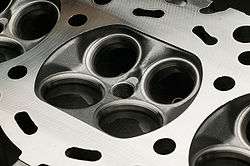
Multi-valve rationale
Multi-valve engine design
A multi-valve engine design typically has three, four, or five valves per cylinder to achieve improved performance. Any four-stroke internal combustion engine needs at least two valves per cylinder: one for intake of air (and often fuel[3]), and another for exhaust of combustion gases. Adding more valves increases valve area and improves the flow of intake and exhaust gases, thereby enhancing combustion, volumetric efficiency, and power output. Multi-valve geometry allows the spark plug to be ideally located within the combustion chamber for optimal flame propagation. Multi-valve engines tend to have smaller valves that have lower reciprocating mass, which can reduce wear on each cam lobe, and allow more power from higher RPM without the danger of valve bounce. Some engines are designed to open each intake valve at a slightly different time, which increases turbulence, improving the mixing of air and fuel at low engine speeds. More valves also provide additional cooling to the cylinder head. The disadvantages of multi-valve engines are an increase in manufacturing cost and a potential increase in oil consumption due to the greater number of valve stem seals. Some SOHC multi-valve engines (such as the Mazda B8-ME) use a single fork-shaped rocker arm to drive two valves (generally the exhaust valves) so that fewer cam lobes will be needed in order to reduce manufacturing costs.
- Three-valve cylinder head
This has a single large exhaust valve and two smaller intake valves. A three-valve layout allows better breathing than a two-valve head, but the large exhaust valve results in an RPM limit no higher than a two-valve head. The manufacturing cost for this design can be lower than for a four-valve design. The three-valve design was common in the late 1980s and early 1990s; and from 2004 the main valve arrangement used in Ford F-Series trucks, and Ford SUVs. The Ducati ST3 V-twin had 3-valve heads.
- Four-valve cylinder head
This is the most common type of multi-valve head, with two exhaust valves and two similar (or slightly larger) inlet valves. This design allows similar breathing as compared to a three-valve head, and as the small exhaust valves allow high RPM, this design is very suitable for high power outputs.
- Five-valve cylinder head
Less common is the five-valve head, with two exhaust valves and three inlet valves. All five valves are similar in size. This design allows excellent breathing, and, as every valve is small, high RPM and very high power outputs are theoretically available. Although, compared to a four-valve engine, a five-valve design should have a higher maximum RPM, and the three inlet ports should give efficient cylinder-filling and high gas turbulence (both desirable traits), it has been questioned whether a five-valve configuration gives a cost-effective benefit over four-valve designs. The rise of direct injection may also make five-valve heads more difficult to engineer, as the injector must take up some space on the head. After making five-valve Genesis engines for several years, Yamaha has reverted to the cheaper four-valve design, examples of the five-valve engines are the various 1.8l 20vT engines manufactured by AUDI AG, later versions of the Ferrari Dino V8 and the very rare 1.6l 4A-GE engine of Toyota.
- Beyond five valves
For a cylindrical bore and equal-area sized valves, increasing the number of valves beyond five decreases the total valve area. The following table shows the effective areas of differing valve quantities as proportion of cylinder bore. These percentages are based on simple geometry and do not take into account orifices for spark plugs or injectors, but these voids will usually be sited in the "dead space" unavailable for valves. Also, in practice, intake valves are often larger than exhaust valves in heads with an even number of valves-per-cylinder:
- 2 = 50%
- 3 = 64%
- 4 = 68%
- 5 = 68%
- 6 = 66%
- 7 = 64%
- 8 = 61%
Alternative technologies
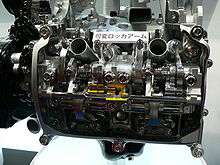
Turbocharging and supercharging are technologies that also improve engine breathing, and can be used instead of, or in conjunction with, multi-valve engines. The same applies to variable valve timing and variable intake manifolds. Rotary valves also offer improved engine breathing and high rev performance but these were never very successful. Cylinder head porting, as part of engine tuning, is also used to improve engine performance.
Cars and trucks
Before 1914
The first motorcar in the world to have an engine with two overhead camshafts and four valves per cylinder was the 1912 Peugeot L76 Grand Prix race car designed by Ernest Henry. Its 7.6-litre monobloc straight-4 with modern hemispherical combustion chambers produced 148 bhp (19.5 HP/Liter(0.32 bhp per cubic inch)). In April 1913, on the Brooklands racetrack in England, a specially built L76 called "la Torpille" (torpedo) beat the world speed record of 170 km/h.[1] Robert Peugeot also commissioned the young Ettore Bugatti to develop a GP racing car for the 1912 Grand Prix. This chain-driven Bugatti Type 18 had a 5-litre straight-4 with SOHC and three valves per cylinder (two inlet, one exhaust). It produced appr. 100 bhp (75 kW; 101 PS) at 2800 rpm (0.30 bhp per cubic inch) and could reach 99 mph (159 km/h). The three-valve head would later be used for some of Bugatti's most famous cars, including the 1922 Type 29 Grand Prix racer and the legendary Type 35 of 1924. Both Type 29 and Type 35 had a 100 bhp 2-liter SOHC 24-valve NA straight-8 that produced 0.82 bhp (1 kW; 1 PS) per cubic inch.
Between 1914 and 1945
A.L.F.A. 40/60 GP was a fully working early racing car prototype made by the company now called Alfa Romeo. Only one example was built in 1914, which was later modified in 1921. This design of Giuseppe Merosi was the first Alfa Romeo DOHC engine. It had four valves per cylinder, 90-degree valve angle and twin-spark ignition.[4] The GP engine had a displacement of 4.5-liter (4490 cc) and produced 88 bhp (66 kW) at 2950 rpm (14.7 kW/liter), and after modifications in 1921 102 bhp (76 kW) at 3000 rpm. The top speed of this car was 88-93 mph (140–149 km/h). It wasn't until the 1920s when these DOHC engines came to Alfa road cars like the Alfa Romeo 6C.
In 1916 US automotive magazine Automobile Topics described a four-cylinder, four-valve-per-cylinder car engine made by Linthwaite-Hussey Motor Co. of Los Angeles, CA, USA: "Firm offers two models of high-speed motor with twin intakes and exhausts.".[5]
Early multi-valve engines in T-head configuration were the 1917 Stutz straight-4 and 1919 Pierce-Arrow straight-6 engines. The standard flathead engines of that day were not very efficient and designers tried to improve engine performance by using multiple valves. The Stutz Motor Company used a modified T-head with 16 valves, twin-spark ignition and aluminium pistons to produce 80 bhp (59 kW) at 2400 rpm from a 360.8 cid (5.8-liter) straight-4 (0.22 bhp per cubic inch). Over 2300 of these powerful early multi-valve engines were built. Stutz not only used them in their famous Bearcat sportscar but in their standard touring cars as well.[6][7][8] In 1919 Pierce-Arrow introduced its 524.8 cid (8.6-liter) straight-6 with 24 valves. The engine produced 48.6 bhp (0.09 bhp per cubic inch) and ran very quietly, which was an asset to the bootleggers of that era.[9][10][11]
Multi-valve engines continued to be popular in racing and sports engines. Robert M. Roof, the chief engineer for Laurel Motors, designed his multi-valve Roof Racing Overheads early in the 20th century. Type A 16-valve heads were successful in the teens, Type B was offered in 1918 and Type C 16-valve in 1923. Frank Lockhart drove a Type C overhead cam car to victory in Indiana in 1926.[12][13]
Bugatti also had developed a 1.5-liter OHV straight-4 with four valves per cylinder as far back as 1914 but did not use this engine until after World War I. It produced appr. 30 bhp (22.4 kW) at 2700 rpm (15.4 kW/liter or 0.34 bhp/cid). In the 1920 Voiturettes Grand Prix at Le Mans driver Ernest Friderich finished first in a Bugatti Type 13 with the 16-valve engine, averaging 91.96 km/h. Even more successful was Bugattis clean sweep of the first four places at Brescia in 1921. In honour of this memorable victory all 16-valve-engined Bugattis were dubbed Brescia. From 1920 through 1926 about 2000 were built.
Peugeot had a triple overhead cam 5-valve Grand Prix car in 1921.[14]
Bentley used multi-valve engines from the beginning. The Bentley 3 Litre, introduced in 1921, used a monobloc straight-4 with aluminium pistons, pent-roof combustion chambers, twin spark ignition, SOHC, and four valves per cylinder. It produced appr. 70 bhp (0.38 bhp per cubic inch). The 1927 Bentley 4½ Litre was of similar engine design. The NA racing model offered 130 bhp (0.48 bhp per cubic inch) and the 1929 supercharged 4½ Litre (Blower Bentley) reached 240 bhp (0.89 bhp per cubic inch). The 1926 Bentley 6½ Litre added two cylinders to the monobloc straight-4. This multi-valve straight-6 offered 180-200 bhp (0.45-0.50 bhp per cubic inch). The 1930 Bentley 8 Litre multi-valve straight-6 produced appr. 220 bhp (0.45 bhp per cubic inch).
In 1931 the Stutz Motor Company introduced a 322 cid (5.3-liter) dual camshaft 32-valve straight-8 with 156 bhp (116 kW) at 3900 rpm, called DV-32. The engine offered 0.48 bhp per cubic inch. About 100 of these multi-valve engines were built. Stutz also used them in their top-of-the-line sportscar, the DV-32 Super Bearcat that could reach 100 mph (160 km/h).[15][16]
The 1935 Duesenberg SJ Mormon Meteor's engine was a 419.6 cid (6.9-liter) straight-8 with DOHC, 4 valves per cylinder and a supercharger. It achieved 400 bhp (298.3 kW) at 5,000 rpm and 0.95 bhp per cubic inch.[17][18]
The 1937 Mercedes-Benz W125 racing car used a supercharged 5.7-liter straight-8 with DOHC and four valves per cylinder. The engine produced 592-646 bhp (441.5-475 kW) at 5800 rpm and achieved 1.71-1.87 bhp per cubic inch (77.8-85.1 kW/liter). The W125 top speed was appr. 200 mph (322 km/h).
After 1945
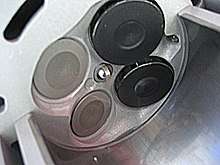
The 1967 Cosworth DFV F1 engine, a NA 3.0-liter V8 producing appr. 400 bhp (298 kW; 406 PS) at 9,000 rpm (101.9 kW/liter), featured four valves per cylinder. For many years it was the dominant engine in Formula One, and it was also used in other categories, including CART, Formula 3000 and Sportscar racing.
Debuting at the 1968 Japanese Grand Prix in the original 300 PS (221 kW; 296 hp) 3.0-liter version the Toyota 7 engine participated in endurance races as a 5.0-liter (4,968 cc) non-turbo V8 with DOHC and 32-valves. It produced 600 PS (441 kW; 592 hp) at 8,000 rpm (88.8 kW/liter) and 55.0 kg⋅m (539 N⋅m; 398 lb⋅ft) at 6,400 rpm.
The first mass-produced car using four valves per cylinder was the British Jensen Healey in 1972 which used a Lotus 907 belt-driven DOHC 16-valve 2-liter straight-4 producing 140 bhp (54.6 kW/liter, 1.20 bhp/cid). What about the Nissan S20 from 1969 used in the Nissan Skyline and Nissan Fairlady Z432?
The 1973 Triumph Dolomite Sprint used an in-house developed SOHC 16-valve 1,998 cc (122 ci) straight-4 that produced appr. 127 bhp (47.6 kW/liter, 1.10 bhp/cid).
The 1975 Chevrolet Cosworth Vega featured a DOHC multi-valve head designed by Cosworth Engineering in the UK. This 122-cubic-inch straight-4 produced 110 bhp (82 kW; 112 PS) at 5600 rpm (0.90 bhp/cid; 41.0 kW/liter) and 107 lb⋅ft (145 N⋅m) at 4800 rpm.[19]
The 1976 Fiat 131 Abarth (51.6 kW/liter), 1976 Lotus Esprit with Lotus 907 engine (54.6 kW/liter, 1.20 bhp/cid), and 1978 BMW M1 with BMW M88 engine (58.7 kW/liter, 1.29 bhp/cid) all used four valves per cylinder. The BMW M88/3 engine was used in the 1983 BMW M635CSi and in the 1985 BMW M5.
The 1978 Porsche 935/78 racer used a twin turbo 3.2-liter flat-6 (845 bhp/630 kW@8,200 rpm; 784 Nm/578 ft.lbs@6,600 rpm). The water-cooled engine featured four valves per cylinder and output a massive 196.2 kW/liter. Porsche had to abandon its traditional aircooling because the multi-valve DOHC hampered aircooling of the spark plugs. Only two cars were built.
Ferrari developed their Quattrovalvole (or QV) engines in the 80s. Four valves per cylinder were added for the 1982 308 and Mondial Quattrovalvole, bringing power back up to the pre-FI high of 245 hp (183 kW) . A very unusual Dino Quattrovalvole was used in the 1986 Lancia Thema 8.32. It was based on the 308 QV's engine, but used a split-plane crankshaft rather than the Ferrari-type flat-plane. The engine was constructed by Ducati rather than Ferrari, and was produced from 1986 through 1991. The Quattrovalvole was also used by Lancia for their attempt at the World Sportscar Championship with the LC2. The engine was twin-turbocharged and destroked to 2.65 litres, but produced 720 hp (537 kW) in qualifying trim. The engine was later increased to 3.0 litres and increased power output to 828 hp (617 kW). The 1984 Ferrari Testarossa had a 4.9-liter flat-12 with four valves per cylinder. Almost 7,200 Testarossa were produced between 1984 and 1991.
In 1985 Lamborghini released a Countach Quattrovalvole, producing 455 PS (335 kW; 449 hp) from a 5.2-liter (5167 cc) Lamborghini V12 engine (64.8 kW/liter).
The Mercedes-Benz 190E 2.3-16 with 16-valve engine debuted at the Frankfurt Auto Show in September 1983 after it set a world record at Nardo, Italy, recording a combined average speed of 154.06 mph (247.94 km/h) over the 50,000 km (31,000 mi) endurance test. The engine was based on the 2.3-liter 8-valve 136 hp (101 kW) unit already fitted to the 190- and E-Class series. Cosworth developed the DOHC light alloy cast cylinder head with four large valves per cylinder. In roadgoing trim, the 190 E 2.3-16 produced 49 hp (36 kW) and 41 ft•lbf (55 N•m) of torque more than the basic single overhead cam 2.3 straight-4 engine on which it was based offering 185 hp (138 kW) at 6,200 rpm (59.2 kW/liter) and 174 lb⋅ft (236 N⋅m) at 4,500 rpm. In 1988 an enlarged 2.5-liter engine replaced the 2.3-liter. It offered double valve timing chains to fix the easily snapping single chains on early 2.3 engines, and increased peak output by 17 bhp (12.5 kW) with a slight increase in torque. For homologation Evolution I (1989) and Evolution II (1990) models were produced that had a redesigned engine to allow for a higher rev limit and improved top-end power capabilities. The Evo II engine offered 235 PS (173 kW; 232 hp) from 2463 cc (70.2 kW/liter).
Saab introduced a 16-valve head to their 2.0-liter (1985 cc) straight-4 in 1984 and offered the engine with and without turbocharger (65.5 kW/liter and 47.9 kW/liter respectively) in the Saab 900 and Saab 9000.
The 2.0-liter Nissan FJ20 was one of the earliest straight-4 mass-produced Japanese engines to have both a DOHC 16-valve configuration (four valves per cylinder, two intake, two exhaust) and electronic fuel injection (EFI) when released in October 1981 in the sixth generation Nissan Skyline. Peak output was 148 hp (110 kW) at 6,000 rpm and 133 lb⋅ft (180 N⋅m) at 4,800 rpm. The FJ20 was also offered with a turbocharger, producing 188 hp (140 kW) at 6,400 rpm and 166 lb⋅ft (225 N⋅m) at 4,800 rpm.
Following Nissan's lead, the 1.6-liter (1,587 cc) Toyota 4A-GE Toyota engine was released in 1983. The cylinder head was developed by Yamaha Motor Corporation and was built at Toyota's Shimayama plant. While originally conceived of as a two-valve design, Toyota and Yamaha changed the 4A-GE to a four-valve after a year of evaluation. It produced 115-140 bhp/86-104 kW@6,600 rpm (54.2-65.5 kW/liter) and 148 Nm/109 lbft@5,800 rpm. To compensate for the reduced air speed of a multi-valve engine at low rpm, the first-generation engines included the T-VIS feature.
In 1986 Volkswagen introduced a multi-valved Golf GTI 16V. The 16-valve 1.8-liter straight-4 produced 139 PS (102 kW; 137 bhp) or 56.7 kW/liter, almost 25% up from the 45.6 kW/liter for the previous 8-valve Golf GTI engine.
The GM Quad 4 multi-valve engine family debuted early 1987. The Quad 4 was the first mainstream multi-valve engine to be produced by GM after the Chevrolet Cosworth Vega. The NA Quad 4 achieved 1.08 bhp (1 kW; 1 PS) per cubic inch (49.1 kW/liter).[2][20] Such engines soon became common as Japanese manufacturers adopted the multi-valve concept.
Three valves
The 1975 Honda Civic introduced Honda's 1.5-liter SOHC 12-valve straight-4 engines. Nissan's 1988–1992 SOHC KA24E engine had three valves per cylinder (two intakes, one exhaust) as well. Nissan upgraded to the DOHC after 1992 for some of the sports cars, including the 240SX.
In 1988, Renault released a 12 valve version of its Douvrin 4 cylinder 2.0l SOHC.
Mercedes and Ford produce three-valve V6 and V8 engines, Ford claiming an 80% improvement in high RPM breathing without the added cost of a DOHC valve train. The Ford design uses one spark plug per cylinder located in the centre, but the Mercedes design uses two spark plugs per cylinder located on opposite sides, leaving the centre free to add a direct-to-cylinder fuel injector at a later date.
The 1989 Citroën XM was the first 3-valve diesel-engined car.
Four valves
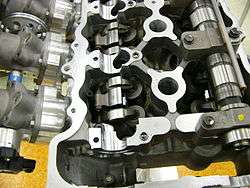
Examples of SOHC four-valve engines include: the Honda F-series engines, D-series engines, all J-series engines, the R-series engines, the Mazda B8-ME, the Chrysler 3.5 L V6 engine.
The V12 engines of many World War II fighter aircraft also used a SOHC configuration with four valves for each cylinder.
The 1993 Mercedes-Benz C-Class (OM604 engine) was the first 4-valve diesel-engined car.
Five valves
Peugeot had a triple overhead cam five-valve Grand Prix car in 1921.[14]
In April 1988 an Audi 200 Turbo Quattro powered by an experimental 2.2-liter turbocharged 25-valve straight-5 rated at 478 kW/650 PS@6,200 rpm (217.3 kW/liter) set two world speed records at Nardo, Italy: 326.403 km/h (202.8 mph) for 1,000 km (625 miles) and 324.509 km/h (201.6 mph) for 500 miles.[21][22]
Mitsubishi were the first to market a car engine with five valves per cylinder, with the 548 cc 3G81 engine in their Minica Dangan ZZ kei car in 1989.[23][24]
Yamaha designed the five-valve cylinder head for the Toyota 4A-GE 20V 1991 Silvertop and 1995 Blacktop engine used in some Toyota Corolla. Yamaha also developed five-valve Formula One engines, the 1989 OX88 V8, 1991 OX99 V12, 1993 OX10 V10 and 1996 OX11 V10, but none of these were very successful. For their YZ250F and YZ450F motocross bikes, Yamaha developed five-valve engines.
Bugatti (EB 110), Ferrari (F355, 360 and F50), Volkswagen - Audi (Audi Quattro) - Skoda (Octavia vRS) and Toyota (4A-GE 20V) have all produced five-valve-engined vehicles.
Six valves
In 1985, Maserati made an experimental 2.0-liter turbo V6 engine with six valves per cylinder (three intakes, three exhaust). It achieved 261 bhp (195 kW; 265 PS) at 7,200 rpm (97.5 kW/liter).[25]
Pushrod
Although most multi-valve engines have overhead camshafts, either SOHC or DOHC, a multivalve engine may be a pushrod overhead valve engine (OHV) design. Chevrolet has revealed a three-valve version of its Generation IV V8 which uses pushrods to actuate forked rockers, and Cummins makes a four-valve OHV straight six diesel, the Cummins B Series (now known as ISB). Ford also uses pushrods in its 6.7L Power Stroke engine using four pushrods, four rockers and four valves per cylinder. The Harley-Davidson Milwaukee Eight engine, introduced in 2016, uses four-valves per cylinder driven by pushrods and a single in-block camshaft.[26][27]
Turbocharged
The 1980 Lotus Essex Turbo Esprit (with type 910 2.2-liter inline four engine) was the first production car to use a multi-valve turbocharged engine.
Motorcycles

Examples of motorcycles with multivalve-engines include:
- 1914 Peugeot Grand Prix racer, 500 cc DOHC 8-valve parallel twin (top speed over 122 km/h).[28]
- 1915 Indian board track racer, 61-cid (1.0-liter) OHV 8-valve V-twin.[29]
- 1921 Triumph Ricardo 499 cc OHV 4-valve single-cylinder machine, copied by Rudge-Whitworth with their 1924 Rudge Four 350 cc OHV 4-valve single-cylinder machine, and 1929 Rudge Ulster 500 cc OHV 4-valve single-cylinder machine.
- 1923 British Anzani 1098cc OHV 8-Valve V-twin, used in Morgan three-wheelers and McEvoy motorcycles
- 1972 Honda XL250 "pent-roof" SOHC 4-valve single-cylinder machine (the first mass-produced 4-valve motorcycle).
- 1973 Yamaha TX500 "pent-roof" 500cc DOHC 8-valve parallel-twin (the first mass-produced DOHC 4-valve per cylinder motorcycle)[30]
- 1977 Honda CB400 SOHC 6-valve parallel-twin.
- 1978 Honda CX500, a 498 cc SOHC, pushrod actuated OHV, 4-valve per cylinder V-twin; 1982 CX500 Turbo was the first factory multi-valve turbocharged motorcycle.
- 1978 Honda CBX1000, a 1,047 cc DOHC 24-valve straight-6 (105 bhp (78 kW; 106 PS)).
- 1979 -1992: Honda NR series, racing & production motorcycles with 8-valve-per-cylinder "oval-piston" V4 engines (actually 32-valve V8s with adjoining cylinders merged).
- 1985 Yamaha FZ750 motorcycle with DOHC 20-valve straight-4 Yamaha "Genesis" engine.
- 1991-2010 Yamaha TDM and TRX parallel twin motorcycles with 5 valves per cylinder
- 1998–2006 Yamaha YZF-R1 superbike with redesigned (more compact) "Genesis" engine. 2006 model delivered 180 bhp (134 kW; 182 PS) at 12,500 rpm (130.3 kW/liter).
The Yamaha XT660 single once had five valves per cylinder, but a subsequent redesign reduced the valve-count to four. The Aprilia Pegaso 650 single also started out with five valves, but current models only have four. The jointly developed BMW F650 single always had four valves.
Aircraft
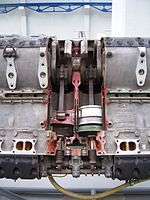
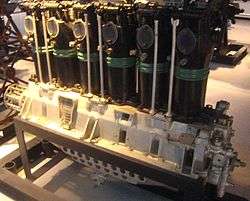
Ettore Bugatti designed several multi-valve aircraft engines. The 1916 Bugatti U-16 1484.3 cid (24.32 L) SOHC 16-cylinder, consisting of two parallel 8-cylinder banks, offered 410 bhp (305 kW) at 2,000 rpm (12.5 kW/liter or 0.28 bhp/cid). Each cylinder had two vertical inlet valves and a single vertical exhaust valve, all driven by rocking levers from the camshaft. Other advanced World War I aircraft engines, such as the 1916 Maybach Mb.IVa that produced 300 bhp (224 kW; 304 PS) at altitude and the 1916 Benz Bz.IV with aluminium pistons and the 1918 Napier Lion (a 450 bhp 24-liter DOHC 12-cylinder), used two intake valves and two exhaust valves.
Long after the King-Bugatti "U-16" aviation engine used them, shortly before World War II, the Junkers aviation firm began production of the Third Reich's most-produced military aviation engine (68,000+ produced), the 1936-designed, 35-litre displacement, inverted-V12, liquid-cooled Junkers Jumo 211, which used a three-valve cylinder head design[31] inherited from Junkers' first inverted V12 design, the 1932-origin Junkers Jumo 210[32] — this was carried through into the later, more powerful 1940-origin Junkers Jumo 213, produced through 1945, the production versions of which (the Jumo 213A and -E subtypes) retained the Jumo 211's three-valve cylinder head design.[33]
The V12 engines of many World War II fighter aircraft used a SOHC configuration with four valves for each cylinder.
An example of a modern multi-valve piston-engine for small aircraft is the Austro Engine AE300. This liquid-cooled turbocharged 2.0-liter (1,991 cc) DOHC 16-valve straight-4 diesel engine uses common rail direct fuel injection and delivers 168 bhp (125 kW; 170 PS) at 3,880 rpm (62.0 kW/liter). The propeller is driven by an integrated gearbox (ratio 1.69:1) with torsional vibration damper. Total power unit weight is 185 kg (408 lb).
Boats
In 1905 car builder Delahaye had experimented with a DOHC marine racing engine with six valves per cylinder. This Delahaye Titan engine was a massive 5190 cid (85.0-liter) four-cylinder that produced 350 bhp (0.07 bhp/cid). It allowed the motor boat Le Dubonnet piloted by Emile Dubonnet to set a new world's speed record on water, reaching 33.80 mph (54.40 km/h) on the lake at Juvisy, near Paris, France.[34]
An example of modern multi-valve engines for small boats is the Volvo Penta IPS Series. These joystick-operated seawater-cooled inboard diesel engines use combined charging (turbo and supercharger, except IPS450) with aftercooler, common rail fuel injection and DOHCs with hydraulic 4-valve technology. Propshaft power ranges from 248 to 850 bhp (185 to 634 kW; 251 to 862 PS) (highest efficiency 59.7 kW/liter for IPS400 3.7-liter straight-4 diesel). Multiple units can be combined.
References
- Kevin Clemens. "An Echo of the Past: The history and evolution of twin-cam engines (European Car, February, 2009)". Archived from the original on 2013-07-02. Retrieved 2011-12-23.
- Dan McCosh. "Auto Tech 88: 4-valves (Popular Science, May 1988, pp. 24, 37-40)". Retrieved 2011-12-23.
- In direct injection engines - such as diesels and later petrol engines - fuel is delivered to the chamber directly via the injector rather than through a valve. In carburetted engines and indirect-injection engines the fuel is mixed with the air outside of the cylinder and both enter together via the intake valve.
- "Alfa Designers". velocetoday.com. Retrieved 2011-12-30.
- Mort Schultz (January 1985). Engines: A Century of Progress (Popular Mechanics, Jan 1985, pp. 95-97, 120, 122). Retrieved 2011-12-26.
- Sports Car Market. "1918 Stutz Series S Roadster (Sportscarmarket.com, Friday, 31 March 2000)". Archived from the original on 16 January 2012. Retrieved 2011-12-23.
- Classic Car Database. "1918 Stutz S Series Roadster Standard Specifications (Classic Car Database)". Retrieved 2011-12-23.
- PaulFreehill. "16-valve Stutz block (YouTube.com video, May 6, 2010)". Retrieved 2011-12-23.
- RM Auctions. "1919 Pierce-Arrow Model 48 Dual-Valve Four-Passenger (RM Auctions, Phoenix, AZ, USA)". Retrieved 2011-12-23.
- Classic Car Database. "1919 Pierce Arrow 48-B-5 Series Touring Standard Specifications (Classic Car Database)". Retrieved 2011-12-23.
- Conceptcarz.com. "1919 Pierce Arrow Model 48 Specifications (Conceptcarz.com)". Retrieved 2011-12-23.
- Northwest Vintage Speedsters. "Roof Alphabetical Index and Images (nwvs.org)". Retrieved 2011-12-23.
- Model T Ford Club of America. "Robert M. Roof (MTFCA.com)". Retrieved 2011-12-23.
- Sports Car Market. "1921 Peugeot 3-liter Racer (Sportscarmarket.com, 30 June 1999)". Archived from the original on 24 October 2011. Retrieved 2011-12-27.
- Donald Osborne. "Honoring the Original American Sports Cars (New York Times, August 12, 2011)". Retrieved 2011-12-23.
- Classic Car Database. "1932 Stutz CD DV 32 Series Super Bearcat Standard Specifications (Classic Car Database)". Retrieved 2011-12-23.
- Richard Owen. "1935 Duesenberg SJ Mormon Meteor (Supercars.net)". Retrieved 2011-12-22.
- Daniel Vaughan. "1935 Duesenberg SJ Special Mormon Meteor (Conceptcarz.com, March 2011)". Retrieved 2011-12-22.
- Wikimedia Commons. "1975 Cosworth Vega advertisement (Motor Trend Magazine, 1975)". Retrieved 2011-12-23.
- Mike Allen (February 1988). Quad 4: The Inside Story (Popular Mechanics, February 1988, pp.62-65). Retrieved 2011-12-23.
- D. Sherman (January 1990). Five valves for Audi (Popular Science, Jan 1990, pp. 35, 37). Retrieved 2011-12-30.
- Brunn Racing. "AUDI 200 N6000 - WORLD RECORD PROTOTYPE (Brunnracing.com, Dec 2011)". Retrieved 2011-12-30.
- "A baby that sprints: tiny Mitsubishi engine blasts off with five valves". Ward's Auto World (April 1989).
- Michael Knowling. "Mighty Minica ZZ-4 (Autospeed Issue 353, 19 October 2005)". Retrieved 2011-12-26.
- Ermanno Cozza & George Lipperts. "Maserati Sei Valvole (Enrico's Maserati Pages, 2002–2004)". Retrieved 2011-12-26.
- Bennett, Jay (2016-08-29). "Milwaukee Eight Multi-Valve". Popular Mechanics. HEARST DIGITAL MEDIA. Retrieved 16 August 2017.
- Cook, Marc. "HD Pushrods". Motorcyclist Online. Bonnier Corporation. Retrieved 16 August 2017.
- Yves J. Hayat & Bernard Salvat. "Peugeot Racers - Part 1 (The Best Motorcycle, Jan 26, 2010)". Retrieved 2011-12-27.
- Yesterdays.nl. "1915 Indian 8 Valve Boardtrack Racer (YouTube.com video, Mar 18, 2010)". Retrieved 2011-12-27.
- "YAMAHA TX500/750: A QUESTION OF BALANCE". Tobyfolwick.com. Retrieved 2015-12-23.
- German language illistration of Jumo 211 three-valve design
- "Flight Magazine, September 9, 1937". flightglobal.com. Flightglobal Archive. September 9, 1937. p. 265. Retrieved March 15, 2017.
At the recent international meeting at Zürich, several of the successful German machines were fitted with the new Junkers 210 petrol engine...Three valves per cylinder are provided, two inlets and one exhaust, operated by push rods and rockers from a single camshaft.
- Culy, Doug (April 4, 2012). "The Junkers Jumo 213 Engine". enginehistory.org. Aircraft Engine Historical Society. Archived from the original on December 21, 2016. Retrieved March 15, 2017.
The Jumo 213 had a three-valve head, but a four-valve head was in development for the “J” version. However, the Jumo 213A is documented as itself having superior high altitude performance at that particular point in time, although the DB 603 was later developed with equal or better features.
- Gérald Guétat (1998-01-10). Classic Speedboats 1916–1939 (Motorbooks International, 1997, p.16, ISBN 0-7603-0464-5). ISBN 9780760304648. Retrieved 2011-12-23.
External links
- Kinematic Models for Design Digital Library (KMODDL) - Movies and photos of hundreds of working mechanical-systems models at Cornell University. Also includes an e-book library of classic texts on mechanical design and engineering.